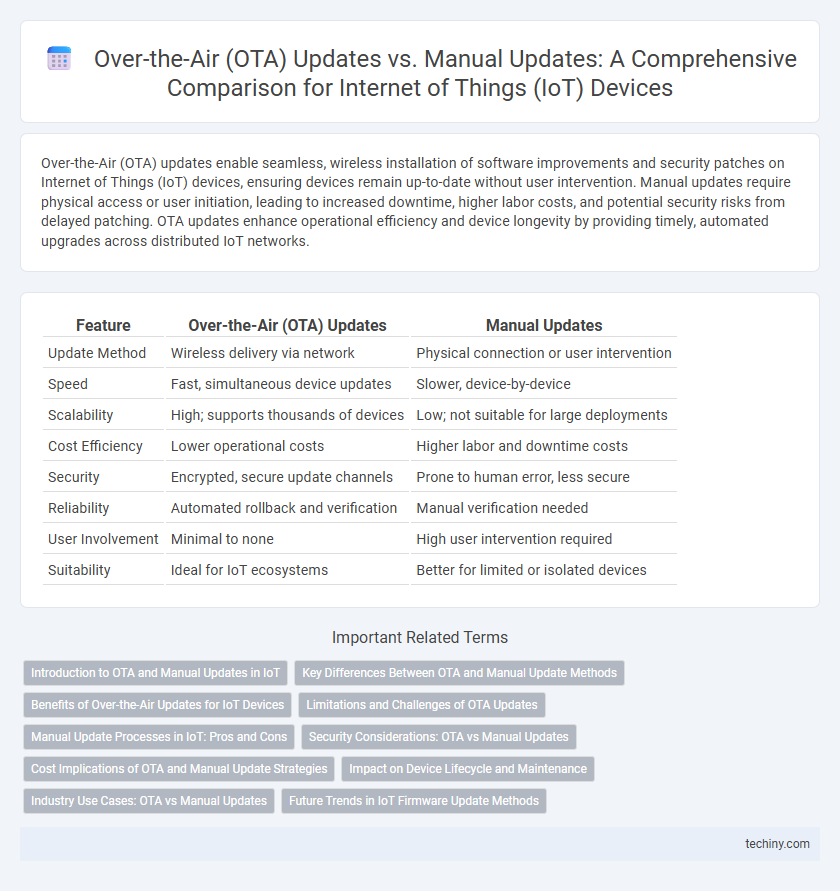Over-the-Air (OTA) updates enable seamless, wireless installation of software improvements and security patches on Internet of Things (IoT) devices, ensuring devices remain up-to-date without user intervention. Manual updates require physical access or user initiation, leading to increased downtime, higher labor costs, and potential security risks from delayed patching. OTA updates enhance operational efficiency and device longevity by providing timely, automated upgrades across distributed IoT networks.
Table of Comparison
| Feature | Over-the-Air (OTA) Updates | Manual Updates |
|---|---|---|
| Update Method | Wireless delivery via network | Physical connection or user intervention |
| Speed | Fast, simultaneous device updates | Slower, device-by-device |
| Scalability | High; supports thousands of devices | Low; not suitable for large deployments |
| Cost Efficiency | Lower operational costs | Higher labor and downtime costs |
| Security | Encrypted, secure update channels | Prone to human error, less secure |
| Reliability | Automated rollback and verification | Manual verification needed |
| User Involvement | Minimal to none | High user intervention required |
| Suitability | Ideal for IoT ecosystems | Better for limited or isolated devices |
Introduction to OTA and Manual Updates in IoT
Over-the-Air (OTA) updates enable remote firmware and software modifications on IoT devices via wireless networks, significantly reducing downtime and maintenance costs. Manual updates require physical access to each device for installation, often leading to increased labor and delayed deployment across extensive IoT ecosystems. OTA updates provide scalable, secure, and efficient management critical for maintaining the performance and security of interconnected IoT devices in smart homes, industrial automation, and connected vehicles.
Key Differences Between OTA and Manual Update Methods
Over-the-Air (OTA) updates enable remote, automated firmware and software deployment across IoT devices, significantly reducing downtime and operational costs compared to manual updates. Manual updates require physical access to each device, increasing labor intensity and the risk of human errors during the installation process. OTA updates enhance scalability and security by allowing centralized management, real-time monitoring, and rapid patching of vulnerabilities without disrupting device functionality.
Benefits of Over-the-Air Updates for IoT Devices
Over-the-Air (OTA) updates enable seamless and remote firmware upgrades for IoT devices, drastically reducing downtime and maintenance costs compared to manual updates. OTA updates enhance device security by promptly delivering patches and vulnerability fixes without physical intervention. Real-time update deployment improves scalability and ensures consistent performance across large IoT networks.
Limitations and Challenges of OTA Updates
Over-the-Air (OTA) updates in Internet of Things (IoT) devices face limitations such as security vulnerabilities, including risks of unauthorized access and data breaches during wireless transmission. Network connectivity issues, such as low bandwidth or intermittent connections, can disrupt the update process, resulting in incomplete or failed installations. Additionally, OTA updates require significant device storage and power resources, which can be challenging for low-power or resource-constrained IoT devices, impacting reliability and update frequency.
Manual Update Processes in IoT: Pros and Cons
Manual update processes in IoT devices offer precise control over firmware version deployment and allow for thorough testing before installation, reducing the risk of introducing bugs. However, manual updates can be time-consuming, labor-intensive, and prone to human error, especially when managing large-scale IoT networks. This approach may also lead to inconsistent update schedules, increasing vulnerability to security threats compared to automated Over-the-Air (OTA) updates.
Security Considerations: OTA vs Manual Updates
Over-the-Air (OTA) updates offer enhanced security by enabling encrypted data transfer and automatic patch deployment, reducing the risk of vulnerabilities exploited in Internet of Things (IoT) devices. Manual updates often involve physical access, increasing exposure to potential interception or tampering during the update process. Securing OTA update protocols with strong authentication and encryption mechanisms is critical to prevent unauthorized access and ensure the integrity of IoT device firmware.
Cost Implications of OTA and Manual Update Strategies
Over-the-Air (OTA) updates significantly reduce operational costs in Internet of Things (IoT) deployments by enabling remote software deployment without the need for on-site maintenance or physical access to devices. Manual update strategies incur higher labor costs and downtime due to the requirement for technicians to perform physical upgrades or interventions, especially across large-scale or geographically dispersed IoT networks. Cost efficiency of OTA updates also extends to minimizing device downtime and accelerating the deployment process, thereby enhancing scalability and reducing total cost of ownership (TCO) for IoT systems.
Impact on Device Lifecycle and Maintenance
Over-the-Air (OTA) updates significantly extend the device lifecycle by enabling remote, real-time firmware upgrades that reduce downtime and maintenance costs. Manual updates, requiring physical access to each device, often lead to delayed patch deployment and increased operational expenses due to labor-intensive processes. OTA technology enhances scalability and security by ensuring rapid response to vulnerabilities and feature enhancements across large IoT networks.
Industry Use Cases: OTA vs Manual Updates
Over-the-Air (OTA) updates enable real-time, remote firmware enhancements across IoT devices, significantly reducing downtime in industrial environments such as manufacturing, energy, and smart cities. Manual updates require physical access to each device, increasing labor costs and operational delays, making them less scalable for large-scale IoT deployments. Industries with critical uptime demands prefer OTA updates for seamless, secure, and scalable device management.
Future Trends in IoT Firmware Update Methods
Future trends in IoT firmware update methods emphasize automated Over-the-Air (OTA) updates to enhance device security, reduce downtime, and enable seamless scalability across large IoT networks. As IoT ecosystems grow, OTA updates leverage edge computing and AI-driven analytics to optimize update timing and minimize bandwidth usage. Manual updates are becoming obsolete due to increased IoT device heterogeneity and the critical need for rapid vulnerability patching in real-time environments.
Over-the-Air (OTA) updates vs Manual updates Infographic

 techiny.com
techiny.com